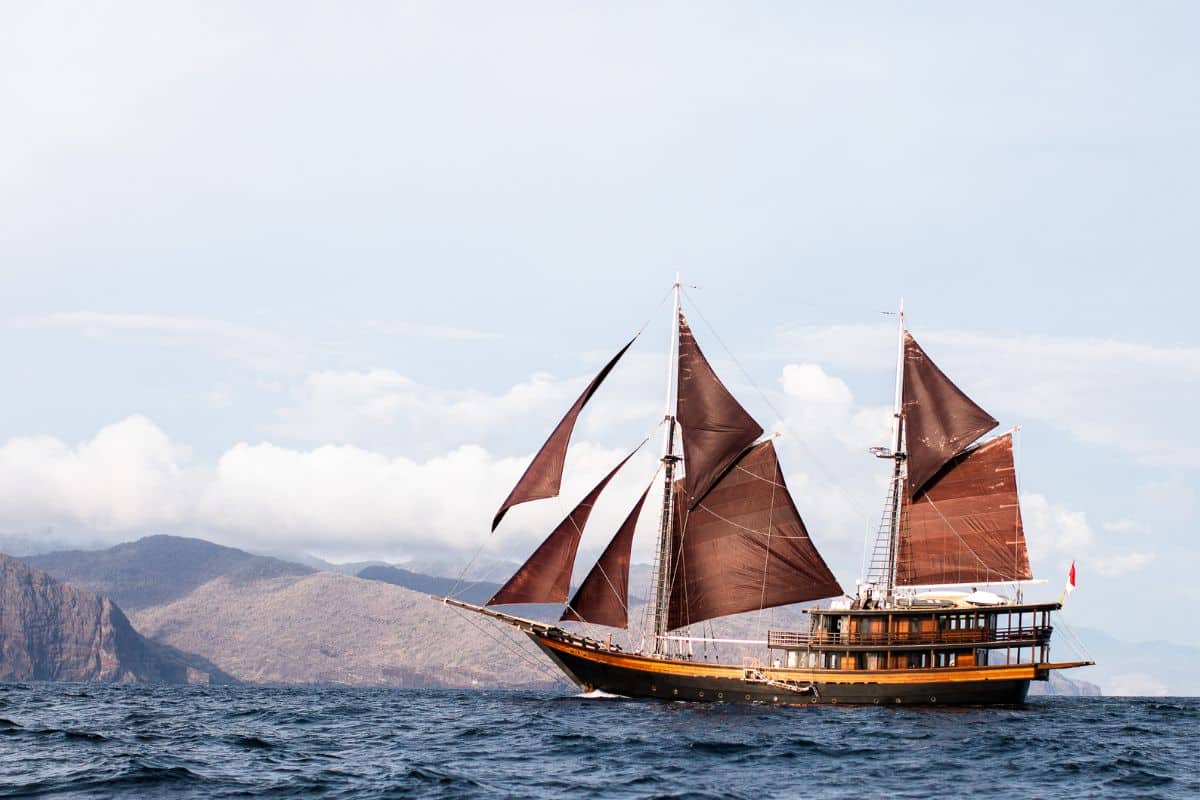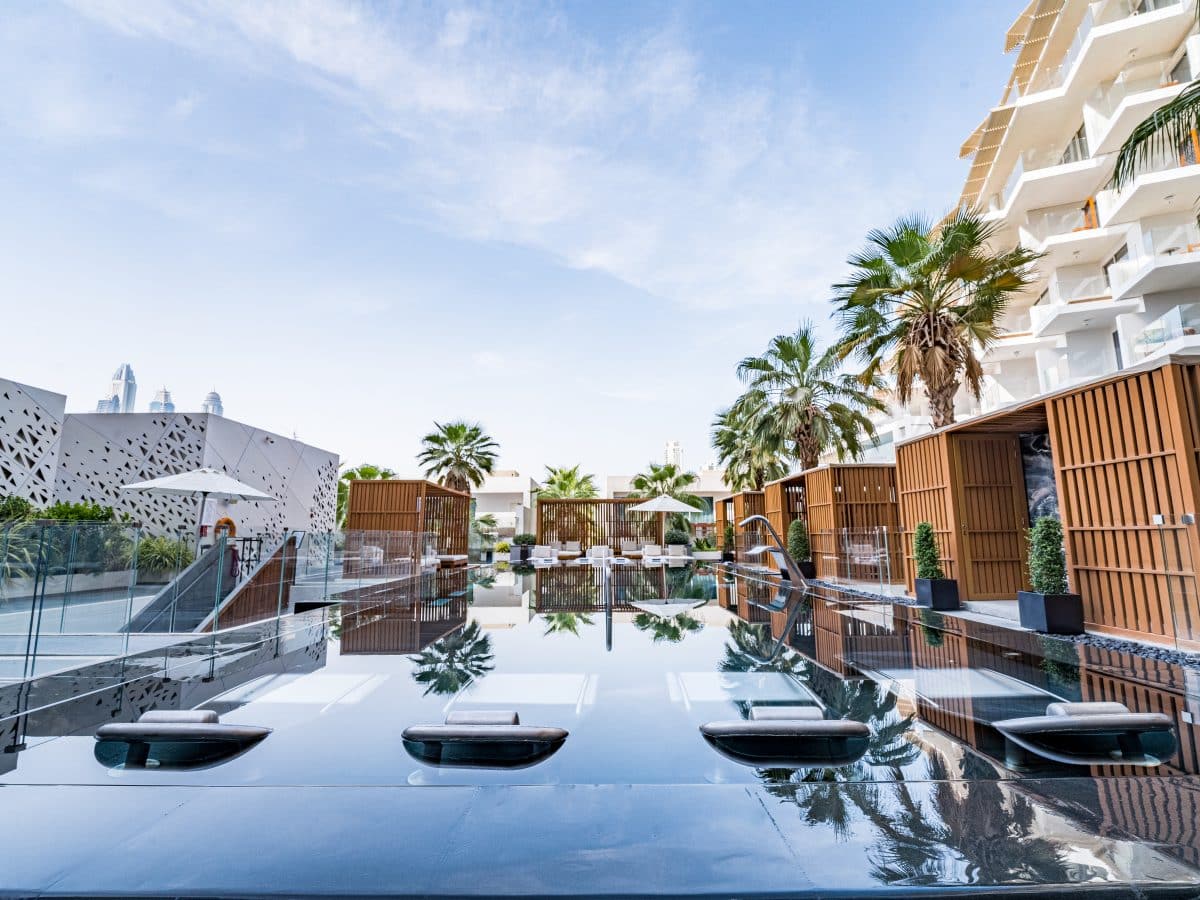For most travellers, visiting Indonesia often begins and ends on the island of Bali. Understandably so, as Bali offers an enchanting introduction to Indonesian culture and landscapes. However, there lies a whole world of over 17,000 islands awaiting to be discovered beyond Bali’s shores.

Sailing on-board Dunia Baru
While you can charter a yacht or sailboat, one of the more romantic ways to explore this region is on–board Dunia Baru, a 51m traditional Indonesian Phinisi vessel that has been transformed into a luxurious private yacht.
The Dunia Baru was originally built by an ancient tribe of boat builders in South Sulawesi called the Konjo. When Singaporean owners, Jing–Yi Wee and Teng Yuan Wee, purchased the yacht, they made sure that every detail was restored to its original state. From teak and rare ulin ironwood to carved wooden hinges, adorning each door and perfectly grained panelling. It embodies the old–world romance of sailing with amenities suited for today’s discerning traveller.

Sleeping up to 14 passengers, travellers on Dunia Baru have the opportunity to create their own itinerary to these unchartered regions. Aboard Dunia Baru, guests slumber in polished comfort while the yacht charts adventures to undiscovered shores and ports omitted from most travel guides. Whilst sailing the oceans, it is not uncommon to spot hammerhead sharks and manta rays in their pristine habitats or other wildlife as you sail amidst the vibrant archipelago.
Where to set sail
Stretching over 3,000 miles of tropical waters and stunning coral reefs, Indonesia is one of the most expansive archipelagos on Earth. Reaching into the central and north–eastern regions, towards the Banda archipelago and Papua, travellers can witness the most exceptional diving spots alongside secluded beaches, towering volcanoes and historical sites that date back to the 15th century. While emperors once battled for these islands, today they remain off the radar for most travellers visiting this popular nation.
As improbable as it seems, north–eastern Indonesia was on track to become a hot destination for jet–setters in the 1990s. Yet, reaching the islands was difficult due to infrequent ferry services and a lack of landing strips for planes. Still to this day, travelling by boat remains the only way to explore Indonesia’s archipelago.

Lesser Sunda Archipelago
Just west of Bali, lies the scenic region known as the Lesser Sunda Islands. This area is celebrated for its volcanic topography and national parks. The most renowned national park is found on Komodo Island.
Set amidst grazing peaks, visitors can witness the infamous Komodo dragon, a dinosaur–looking creature that is not only endemic to the area, but also the largest lizard in the world and one of the few with a venomous bite.

A short boat ride from the dragon’s lair, visitors can explore the island Flores. Home to the mesmerizing Kelimutu National Park, Flores is known for its multi–coloured crater lakes. These waters have become a focal point for their chameleon–like qualities, with shades that fluctuate from blues to reds to greens. This captivating display is the result of the different gases and minerals that percolate below, altering the colour palette of the surface.
The island’s culture is defined by the presence of native tribes and ethnic groups. Take, for instance, the Manggarai people, who express their cultural identity through the Caci dance — a dramatic performance where whip–bearing men enact a symbolic battle to the pulse of drums. Yet, it is Alor Island that stands out for its indigenous culture. With its assembly of more than 50 tribes, it is one of Indonesia’s most ethnically varied islands. Travellers can visit Alor’s quaint villages that offer a glimpse into their unique way of life.
Below the sea’s surface near Kawula Island, divers encounter a dynamic underwater scene, where volcanic vents create a tapestry of warm and cool currents, amidst turtles, rays, and sharks.

Raja Ampat Archipelago
Located in Indonesia’s southwest Papua province, the Raja Ampat islands stand out as the most biodiverse marine habitat on the planet. A staggering 75 percent of all coral species on the planet thrive in these waters, along with a diverse collection of more than 2,500 types of fish.
This extraordinary concentration of marine species owes much to the islands’ prime location on the ‘Ring of Fire,’ — a series of oceanic trenches and volcanic arcs which have fostered the creation of a rich underwater habitat.
Among the archipelago’s many diving spots, Magic Mountain stands out for its vibrant seamounts swathed in coral reefs. It is known to attract a constant ballet of marine life. At least 23 of the fish species found in this region are endemic, including species such as the walking shark, flasher wrasse, damselfish, coral goby, cardinal fish and dottyback.
Within the vast array of 1,500 islands that make up this far–flung archipelago, four islands stand as jewels among them. Known collectively as the ‘Four Kings,’ the islands of Misool, Waigeo, Salawati, and Batanta each offer their own unique splendours. Misool is renowned for its ancient cave paintings and dramatic limestone cliffs that surge from the depths of the sapphire sea. Whereas, the islands of Waigeo and Salawati have become sanctuaries of biodiversity, teeming with an array of bird species, most notably the resplendent Crimson Sunbird.
From Waigeo, travellers can cross the Dampier Strait to Batanta, an island covered in dense rainforests and dominated by a towering central mountain range. This elevated terrain fosters a climate rich with fog and regular rainfall, which in turn sustains the island’s intricate system of lively rivers and waterfalls.

Banda Islands
The 11 small volcanic islands of the Bandas are at the heart of an expanse referred to as the ‘Coral Triangle,’ and sometimes as “the Amazon of the ocean”. This marine sanctuary boasts around 600 varieties of reef–building corals, over 2,000 types of reef fish, and hosts six of the seven known marine turtle species.
The three main islands — Banda Neira, Gunung Api and Banda Besar — ring in the harbour and main town, also called Banda Neira. Known as the Spice Islands, this territory was at the heart of the global spice trade, mainly attributed to the nutmeg trees that are native to the islands. At the time, nutmeg was more valuable by weight than gold, leading to so called “nutmeg wars” as an attempt to control the region.
Travellers who visit the shores of these islands will witness its colonial past featuring architecture and fortresses dating back to this era. A mix of nature and history gives the archipelago its allure, placing it on UNESCO’s Tentative List, in consideration for World Heritage status.
Follow www.abtraveller.com and @abtravellerme to stay updated on the latest travel news













